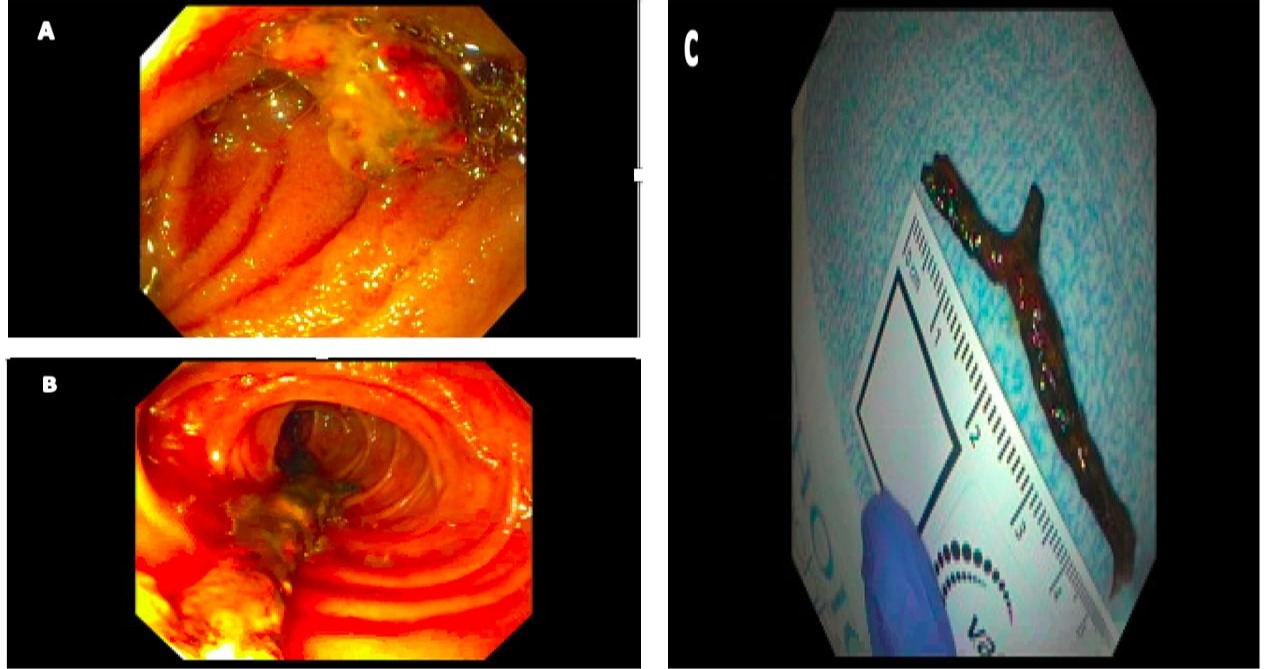Back
Poster Session A - Sunday Afternoon
A0025 - A Case of Biliary Cast Syndrome After Liver Transplantation
Sunday, October 23, 2022
5:00 PM – 7:00 PM ET
Location: Crown Ballroom
.jpg)
Shuhaib S. Ali, DO
University of Texas Health San Antonio
San Antonio, TX
Presenting Author(s)
Shuhaib Ali, DO1, Farah H. Ladak, MD2, Hari Sayana, MD3
1University of Texas Health San Antonio, San Antonio, TX; 2University of Texas Health Science Center, San Antonio, TX; 3UT Health San Antonio, San Antonio, TX
Introduction: Biliary Cast Syndrome (BCS) is characterized by biliary cast and debris resulting in biliary obstruction. It is a complication of orthotopic liver transplant (OLT) population occurring in 4-18% of recipients. Patients can present with cholangitis and graft damage or loss. Symptoms include fever, jaundice, and cholestatic liver enzyme elevation. Twenty-two percent of patients with BCS require repeat OLT. We present a case of BCS after OLT.
Case Description/Methods: A 67-year-old man with history of hypertension, alcoholic cirrhosis status post orthotic liver transplant three months ago with no acute complaints was admitted to the hospital for evaluation of elevated liver associated enzymes (LAEs). His liver transplant biliary anastomosis was a Roux-en-Y choledochojejunostomy due to poor quality of the recipient hepatic duct. The patient was compliant with his transplant clinic visits and immunosuppression medications. Initial vital signs and physical exam were unremarkable. The alkaline phosphatase was elevated to 790, alanine aminotransferase was elevated to 86, aspartate aminotransferase was elevated to 199, total bilirubin was 0.9, and gamma-glutamyl transferase was elevated to 1478. Liver biopsy showed mild portal edema with ductal proliferation and associated neutrophilic inflammation without evidence of rejection or infection. He underwent endoscopic retrograde cholangiopancreatography (ERCP). A balloon enteroscope was used to reach the choledochojejunal anastomosis where a biliary stone cast was found protruding into the lumen of the jejunum. A biopsy forceps was used to remove the 5.5 cm biliary cast. A cholangiogram was performed with contrast into the right and left intrahepatic ducts without any remaining stones. The patient LAEs improved post-procedurally and he was treated with Ciprofloxacin for five days.
Discussion: Biliary complications after OLT occur in 10-25% of cases after liver transplantation. While biliary strictures, bile leaks and bile duct stones account for a majority of these complications, it is important to keep BCS on the differential diagnosis as well. The mechanism of cell injury can be a result of ischemia, acute cellular rejection, chronic rejection, infection or bile stasis resulting in desquamated epithelial cells forming hard casts with bile components. Treatment can include ERCP with sphincterotomy with removal of casts, lithotripsy with stent placement, and percutaneous drainage.

Disclosures:
Shuhaib Ali, DO1, Farah H. Ladak, MD2, Hari Sayana, MD3. A0025 - A Case of Biliary Cast Syndrome After Liver Transplantation, ACG 2022 Annual Scientific Meeting Abstracts. Charlotte, NC: American College of Gastroenterology.
1University of Texas Health San Antonio, San Antonio, TX; 2University of Texas Health Science Center, San Antonio, TX; 3UT Health San Antonio, San Antonio, TX
Introduction: Biliary Cast Syndrome (BCS) is characterized by biliary cast and debris resulting in biliary obstruction. It is a complication of orthotopic liver transplant (OLT) population occurring in 4-18% of recipients. Patients can present with cholangitis and graft damage or loss. Symptoms include fever, jaundice, and cholestatic liver enzyme elevation. Twenty-two percent of patients with BCS require repeat OLT. We present a case of BCS after OLT.
Case Description/Methods: A 67-year-old man with history of hypertension, alcoholic cirrhosis status post orthotic liver transplant three months ago with no acute complaints was admitted to the hospital for evaluation of elevated liver associated enzymes (LAEs). His liver transplant biliary anastomosis was a Roux-en-Y choledochojejunostomy due to poor quality of the recipient hepatic duct. The patient was compliant with his transplant clinic visits and immunosuppression medications. Initial vital signs and physical exam were unremarkable. The alkaline phosphatase was elevated to 790, alanine aminotransferase was elevated to 86, aspartate aminotransferase was elevated to 199, total bilirubin was 0.9, and gamma-glutamyl transferase was elevated to 1478. Liver biopsy showed mild portal edema with ductal proliferation and associated neutrophilic inflammation without evidence of rejection or infection. He underwent endoscopic retrograde cholangiopancreatography (ERCP). A balloon enteroscope was used to reach the choledochojejunal anastomosis where a biliary stone cast was found protruding into the lumen of the jejunum. A biopsy forceps was used to remove the 5.5 cm biliary cast. A cholangiogram was performed with contrast into the right and left intrahepatic ducts without any remaining stones. The patient LAEs improved post-procedurally and he was treated with Ciprofloxacin for five days.
Discussion: Biliary complications after OLT occur in 10-25% of cases after liver transplantation. While biliary strictures, bile leaks and bile duct stones account for a majority of these complications, it is important to keep BCS on the differential diagnosis as well. The mechanism of cell injury can be a result of ischemia, acute cellular rejection, chronic rejection, infection or bile stasis resulting in desquamated epithelial cells forming hard casts with bile components. Treatment can include ERCP with sphincterotomy with removal of casts, lithotripsy with stent placement, and percutaneous drainage.

Figure: A.) Biliary cast on endoscopy
B.) Biliary cast removal on endoscopy
C.) Biliary cast specimen
B.) Biliary cast removal on endoscopy
C.) Biliary cast specimen
Disclosures:
Shuhaib Ali indicated no relevant financial relationships.
Farah Ladak indicated no relevant financial relationships.
Hari Sayana indicated no relevant financial relationships.
Shuhaib Ali, DO1, Farah H. Ladak, MD2, Hari Sayana, MD3. A0025 - A Case of Biliary Cast Syndrome After Liver Transplantation, ACG 2022 Annual Scientific Meeting Abstracts. Charlotte, NC: American College of Gastroenterology.
